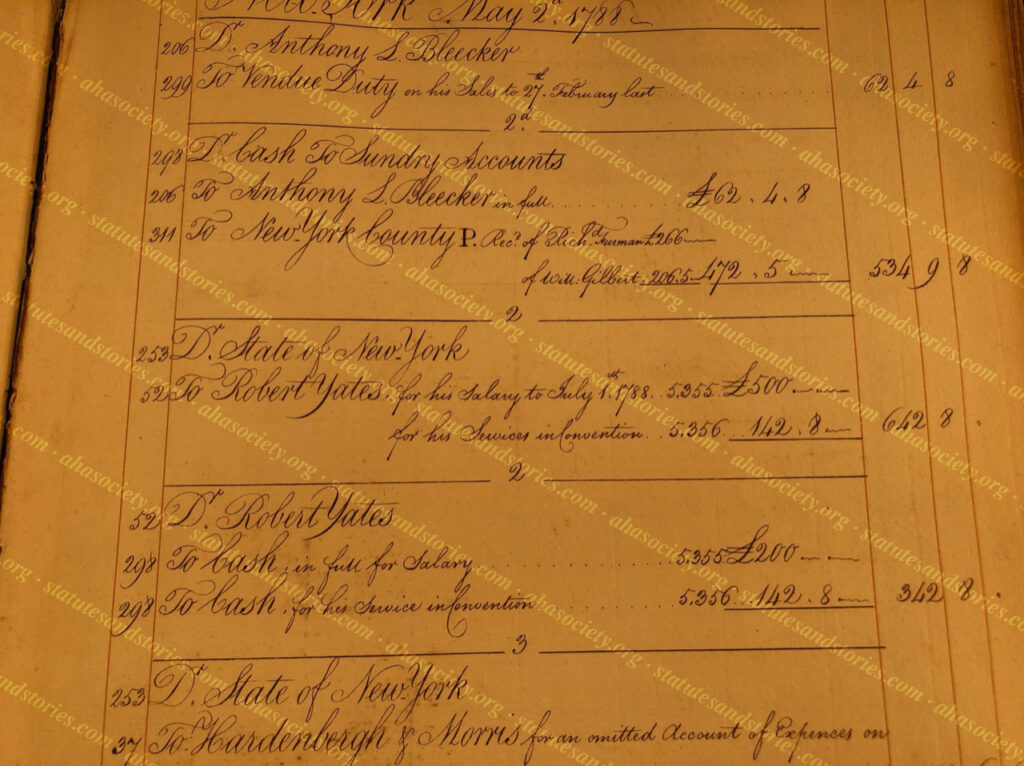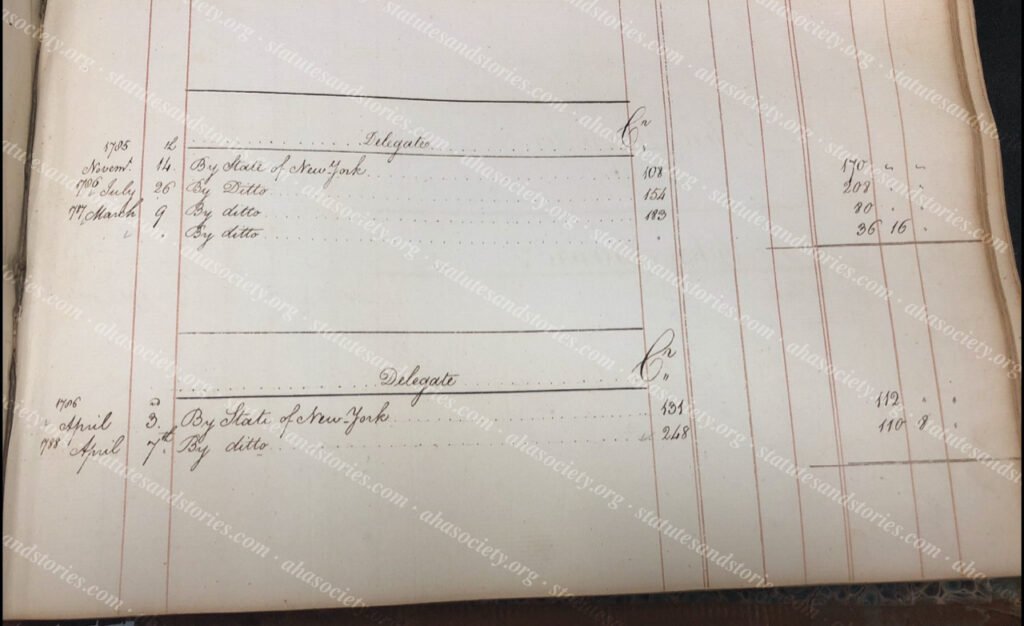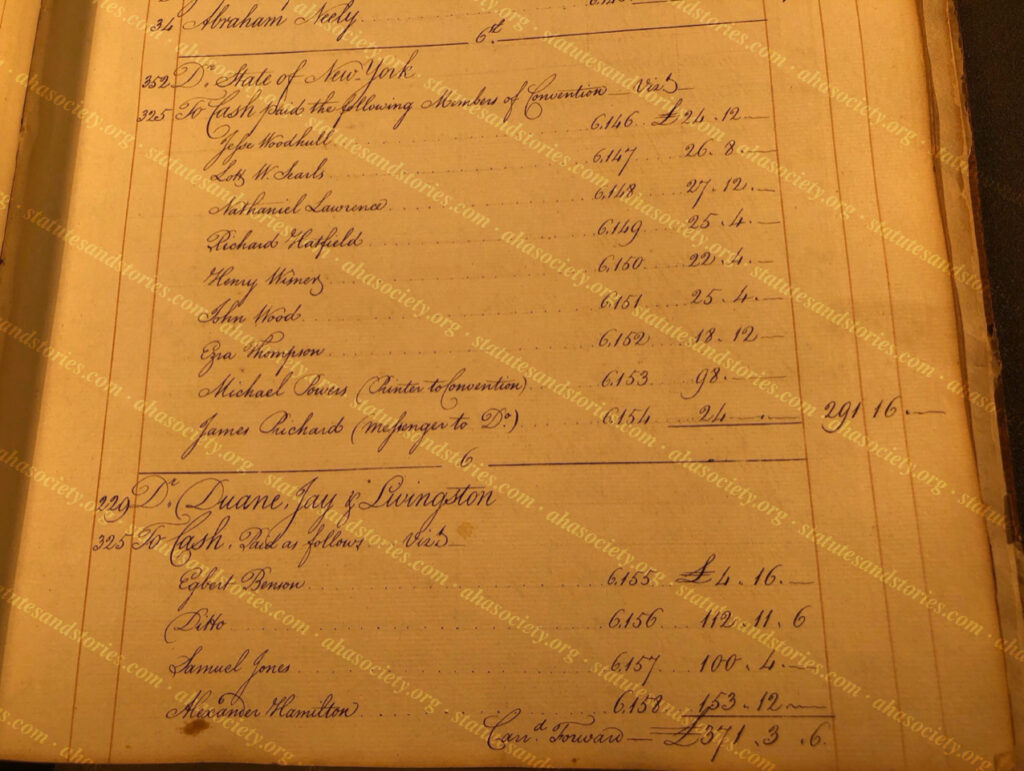Newly uncovered Hamilton records relating to the Constitutional Convention and New York Ratification Convention
Late breaking news (developing story)
Draft Post by Adam Levinson, Esq., and Sergio Villavicencio, Vice President of the Alexander Hamilton Awareness Society.
This article builds on a prior blog post (Part 1) describing newly uncovered journal entries found among 826 volumes of registers and ledgers in the New York State Archives. As described in Part I, these newly revealed primary sources conclusively evidence payments to Alexander Hamilton for his attendance at the Annapolis Convention in 1786 and the Constitutional Convention in 1787. Until these records were discovered historians were only able to speculate whether Hamilton and his New York co-delegates Robert Yates and John Lansing, Jr., were reimbursed for their work in Philadelphia during the summer of 1787.
While conducting continuing research for the Cover Letter documentary this week, Sergio Villavicencio located the following records described below. Image 1, a May 2, 1788 journal entry, proves that Robert Yates was reimbursed 142 pounds and 8 shillings for attending the Constitutional Convention. According to the journal entry Yates was reimbursed “for his services in Convention.” Yates was one of Alexander Hamilton’s two co-delegates representing New York in Philadelphia. As indicated by Image 2, New York’s third delegate, John Lansing, may also have been reimbursed 110 pounds and 8 shillings for attending the Constitutional Convention.

By contrast, Alexander Hamilton was reimbursed 121 pounds and 12 shillings for attendance at the Philadelphia Convention. Click here for a link to Part 1. The fact that Yates was paid 21 pounds more than Hamilton may strike some as remarkable, since Hamilton spent more time in Philadelphia than Yates!
Yates and Lansing both left Philadelphia in protest in July of 1787 after it became clear that a version of the Virginia Plan would be adopted by the Convention. Yates and Lansing were ardent “Clintonians” who prioritized states rights, supported the status quo and opposed making dramatic changes to the Articles of Convention. By contrast, Alexander Hamilton, George Washington and other proto-Federalists understood the importance of replacing the Articles of Confederation with a more “energetic” federal government. Click here for a discussion of Governor Clinton’s efforts to sabotage Hamilton in Philadelphia by shackling him with proto-Anti-Federalists Yates and Lansing on the New York delegation to the Constitutional Convention.
While Hamilton also departed the Convention (on or about June 30), he briefly returned to the Convention on August 13. Hamilton’s third trip to Philadelphia placed him at the Convention from September 6 until the final day of the Convention on September 17. Hamilton would be the only New York delegate to sign the Constitution.
Thus, Hamilton attended the Convention for a total of at least 41 working days (May 25 – June 29, August 13, September 6 – 17). Yet Yates only attended the Convention for 37 working days (May 25 – July 9). It is thus puzzling why Yates would have been paid 142 pounds and 8 shillings while Hamilton was only paid 121 pounds and 12 shillings.
We had the privilege to consult with Professor John Kaminski from the Center for the Study of the American Constitution who reasons that the extra payment to Yates – who was the mayor of Albany at the time – may be the result of the distance that the delegates travelled. “Hamilton travelled from New York City to Philadelphia while Yates probably traveled from Albany to Philadelphia.” Kaminski’s reasoning is consistent with the differences in reimbursements to delegates to the New York Ratification Convention which is described below.
Interestingly, New York delegate John Lansing was only paid 110 pounds and 8 shillings for work in Philadelphia (if this was the case). Unlike Hamilton and Yates who both arrived at the Constitutional Convention on May 25, Lansing appeared for the first time on June 2. This would help explain why Lansing’s reimbursement was less than Hamilton and Yates’ payments.
According to Image 2, Lansing was reimbursed for work as a “Delegate” on April 7, 1788. It is likely that this 1788 payment was for his work at the Constitutional Convention because he was no longer a member of the New York Assembly in 1787. He served as a member from 1781-1784 and as Speaker in 1786. At the time of the Convention he was mayor of Albany. Lansing would subsequently serve on the New York Supreme Court beginning in 1790.

Some might be interested in quantifying the value of these payments. To put these payments into context, Yates’ salary as one of three New York Supreme Court judges was £500 New York pounds. Astute readers will recall that the United States dollar was not created until after the U.S. Mint was created in 1792. Click here for a discussion of the Act Establishing the Mint and Treasury Secretary Alexander Hamilton’s Report on Establishing the Mint (which proposed the use of silver dollars as the basic unit of monetary value, to replace the unwieldy non-decimalized English system of pounds, shilling and pence). Based on additional records discovered this week, it appears that the New York Senate salary for Abraham Yates (Robert Yates’ uncle) was 170 pounds and 8 shillings.
According to Professor Kaminski, New York Governor George Clinton’s salary was 1,500 pounds. Clinton’s generous salary, however, was intended to allow Clinton to “defray the entertaining expenses necessary to maintain the dignity of the state.” Because Clinton did no entertaining and largely ignored members of Congress, foreign diplomats and other dignitaries, he accumulated “a very large and opulent estate.” Clinton’s salary was eventually reduced by 300 pounds when this issue was publicized by his critics.
In sum, we know that Hamilton and Yates were reimbursed for attending the Constitutional Convention in Philadelphia. Stay tuned as we analyze additional records including Image 2 above with regard to co-delegate John Lansing. Click here for a discussion of Lansing’s role as the presiding judge in the trial of Levi Weeks.
Reimbursement for New York Ratification Convention
Although we were initially searching for records related to the Constitutional Convention, we are excited to announce that we also found potentially significant documents pertaining to the New York Ratification Convention.
Based on records discussed below, we are gaining a better understanding of reimbursements paid to the delegates elected to the New York Ratification Convention in Poughkeepsie.
Following a bitterly contested ratification convention, on July 26, 1788 New York became the 11th state to ratify the Constitution. Having approved the Constitution by a narrow vote of 30-27, the New York Ratifying Convention unanimously voted for a carefully worded motion to prepare a circular letter to the states requesting a second general convention to consider Constitutional amendments.
The New York circular letter was drafted by John Jay, Alexander Hamilton and John Lansing, Jr. It will be discussed in a future post. While several states had also voted for ratification based on the expectation of the adoption of a future bill of rights (the Massachusetts compromise), New York’s ratification message was the longest by any state convention. New York anti-Federalists proposed 25 issues for the Bill of Rights and 31 Constitutional amendments.
Image 3 below evidences reimbursement of several important delegates to the New York Ratification Convention. This image contains intriguing information about delegates who span across a spectrum of political views represented at the Poughkeepsie Convention. Additionally, this data supports the suggestion that delegates were reimbursed based in part on the distance they travelled.
-
The smallest reimbursement in Image 3 of £18 was for Ezra Thompson from Dutchess County (where Poughkeepsie is the County seat). Thompson was an Anti-federalist;
-
Nathanial Lawrence from Queens County was paid £27 which seemingly reflects the greater distance travelled. Lawrence was an Anti-federalist who switched sides to vote for ratification;
-
Henry Wizner from Orange County, which adjoins Dutchess County, was paid £22. Wizner was an Anti-federalist who voted against ratification;
-
John Wood from Orange County was paid £25. Wood was an Anti-federalist who voted against ratification;
-
Richard Hatfield from Westchester County was also paid £25. Hatfield was a Federalist who voted to ratify.
-
Lot Searls from Westchester County was paid £26. Searls was a Federalist who voted to ratify;
-
Jesse Woodhull from Orange County was paid £24. Woodhull was an anti-federalist who voted to ratify.
This topic, including New York’s “Act for the Payment of the Salaries of the Officers of Government, and other Contingent Charges,” is discussed in the multi-volume Documentary History of the Ratification of the Constitution.

Also pictured in Image 3 are reimbursements to Alexander Hamilton of £153 pounds and 12 shillings. It is unclear how this amount was calculated and what specific services or expenses were included. Egbert Benson, the New York Attorney General (and Federalist delegate), was paid £116 pounds, 27 shillings and 6 pence. Anti-Federalist delegate Samuel Jones was paid £100 pounds and 4 shillings. Additional records are being studied which are expected to help contextualize this information.
We are also in the process of seeking proof that Alexander Hamilton was responsible for the Albany broadside printed by Claxton & Babcock. The Albany broadside was printed by the “Federal Committee” between February and March of 1788 in advance of the election of delegates to the New York Ratification Convention. We theorize that if it can be established that Hamilton was behind the printing of the Albany broadside, this would be further evidence of the Hamilton Authorship Thesis (which proposes that Hamilton wrote the Constitution’s Cover Letter). Importantly, the Albany broadside prominently prints the Constitution’s Cover Letter and George Washington’s name above the Constitution. By featuring Washington’s name alongside the Constitution, the Albany broadside echos the Federalist message that George Washington supported ratification and was likely willing to serve as the nation’s first president.
It is our goal that the discoveries described in this draft blog post will eventually be developed into a scholarly article. We look forward to sharing our ongoing research and its implications, once our findings are ready for peer review.
Additional Reading:
New York Ratifies the Constitution (New York Historical Society)
Introductory Note: New York Ratifying Convention (Founders Archive)
The Strategy of Rhetoric: Campaigning for the American Constitution (Riker and Mueller, 1996)